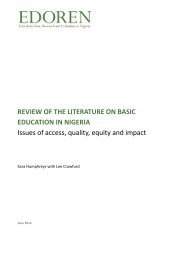review-of-the-literature-on-basic-education-in-nigeria-june-2014-3-1
review-of-the-literature-on-basic-education-in-nigeria-june-2014-3-1
review-of-the-literature-on-basic-education-in-nigeria-june-2014-3-1
You also want an ePaper? Increase the reach of your titles
YUMPU automatically turns print PDFs into web optimized ePapers that Google loves.
Review <str<strong>on</strong>g>of</str<strong>on</strong>g> <str<strong>on</strong>g>the</str<strong>on</strong>g> <str<strong>on</strong>g>literature</str<strong>on</strong>g> <strong>on</strong> <strong>basic</strong> educati<strong>on</strong> <strong>in</strong> Nigeria5.3.1 Nati<strong>on</strong>al m<strong>on</strong>itor<strong>in</strong>g <str<strong>on</strong>g>of</str<strong>on</strong>g> child learn<strong>in</strong>g outcomesNati<strong>on</strong>wide MLA studies were carried out <strong>in</strong> 1996, 2001, 2004 and 2006, all dem<strong>on</strong>strat<strong>in</strong>g very lowlearn<strong>in</strong>g outcomes. Nati<strong>on</strong>al mean percentage test scores atta<strong>in</strong>ed by Primary 4 children <strong>in</strong> <str<strong>on</strong>g>the</str<strong>on</strong>g> firststudy <strong>in</strong> 1996 were 32% <strong>in</strong> numeracy and 25% <strong>in</strong> literacy. Nati<strong>on</strong>al mean scores at <str<strong>on</strong>g>the</str<strong>on</strong>g> JSS level <strong>in</strong> 2004were 25% <strong>in</strong> Ma<str<strong>on</strong>g>the</str<strong>on</strong>g>matics and 32% <strong>in</strong> English (FME 2010). ESSPIN (2009a) reports that, to <str<strong>on</strong>g>the</str<strong>on</strong>g> extent<str<strong>on</strong>g>the</str<strong>on</strong>g>se results are comparable with o<str<strong>on</strong>g>the</str<strong>on</strong>g>r countries, <str<strong>on</strong>g>the</str<strong>on</strong>g> 2004 results were <str<strong>on</strong>g>the</str<strong>on</strong>g> worst <strong>in</strong> Africa. In Maths,JSS results were not substantially different between girls and boys and between urban and rural areas.Private school students performed slightly better than public school students. In English, urban andfemale students performed slightly better than average, and private school students aga<strong>in</strong> performedbetter than public school students. However, all results were low.UBEC too has c<strong>on</strong>ducted a series <str<strong>on</strong>g>of</str<strong>on</strong>g> nati<strong>on</strong>al assessments: <strong>in</strong> 2001 <strong>in</strong> English and Maths <strong>in</strong> Primary 4(UBEC 2001); <strong>in</strong> all four core subjects <strong>in</strong> all three upper primary grades <strong>in</strong> 2003 (UBEC 2007); and <strong>in</strong>Primary 6 and all three JSS grades <strong>in</strong> 2006 (UBEC 2009). In all three assessments pupil marks weregenerally very low and it was reported that <str<strong>on</strong>g>the</str<strong>on</strong>g>ir low level <str<strong>on</strong>g>of</str<strong>on</strong>g> English prevented many fromunderstand<strong>in</strong>g <str<strong>on</strong>g>the</str<strong>on</strong>g> test <strong>in</strong>structi<strong>on</strong>s (UBEC 2007 and 2009). Generally, better results were ga<strong>in</strong>ed <strong>in</strong>urban schools than <strong>in</strong> rural schools but <str<strong>on</strong>g>the</str<strong>on</strong>g>re was a noticeable shift <strong>in</strong> mean gender atta<strong>in</strong>ment patternsbetween 2001 and 2003 as girls <strong>on</strong> average performed better than boys <strong>in</strong> some states <strong>in</strong>clud<strong>in</strong>g <strong>in</strong>Ma<str<strong>on</strong>g>the</str<strong>on</strong>g>matics, although results still generally rema<strong>in</strong>ed low: state averages rarely reached 30% across<str<strong>on</strong>g>the</str<strong>on</strong>g> grades <strong>in</strong> English or Social Studies, whereas children fared slightly better <strong>in</strong> Primary 6 Ma<str<strong>on</strong>g>the</str<strong>on</strong>g>maticsand Primary Science with nati<strong>on</strong>al averages <str<strong>on</strong>g>of</str<strong>on</strong>g> 36% and 40% respectively. In 2006, Primary 6 meanscores for all four subjects were slightly higher, rang<strong>in</strong>g between 40 and 50%, and higher too than for all<str<strong>on</strong>g>the</str<strong>on</strong>g> JSS grades, which were exceed<strong>in</strong>gly low.The 2010 NEDS provides a simple measure <str<strong>on</strong>g>of</str<strong>on</strong>g> literacy: a pers<strong>on</strong> who can read aloud all or part <str<strong>on</strong>g>of</str<strong>on</strong>g> asentence <strong>in</strong> <strong>on</strong>e <str<strong>on</strong>g>of</str<strong>on</strong>g> <str<strong>on</strong>g>the</str<strong>on</strong>g> three ma<strong>in</strong> Nigerian languages or <strong>in</strong> English is c<strong>on</strong>sidered to be literate. This isnot a very robust test but does cover a nati<strong>on</strong>ally representative sample (NPC and RTI Internati<strong>on</strong>al2011). A World Bank analysis <str<strong>on</strong>g>of</str<strong>on</strong>g> <str<strong>on</strong>g>the</str<strong>on</strong>g> data <strong>in</strong>dicates that, even when us<strong>in</strong>g this limited test, two-thirds <str<strong>on</strong>g>of</str<strong>on</strong>g>children rema<strong>in</strong> illiterate after Primary 6, with even higher figures for <str<strong>on</strong>g>the</str<strong>on</strong>g> North East (Global Educati<strong>on</strong>First Initiative 2013). As Figure 5.1 shows, literacy rates are much higher <strong>in</strong> <str<strong>on</strong>g>the</str<strong>on</strong>g> sou<str<strong>on</strong>g>the</str<strong>on</strong>g>rn part <str<strong>on</strong>g>of</str<strong>on</strong>g> <str<strong>on</strong>g>the</str<strong>on</strong>g>country but <str<strong>on</strong>g>the</str<strong>on</strong>g>re is substantial variati<strong>on</strong> am<strong>on</strong>g states.S<strong>in</strong>ce <str<strong>on</strong>g>the</str<strong>on</strong>g> literacy test does not require <str<strong>on</strong>g>the</str<strong>on</strong>g> resp<strong>on</strong>dent to understand <str<strong>on</strong>g>the</str<strong>on</strong>g> sentence, it clearly does notgive an <strong>in</strong>dicati<strong>on</strong> <str<strong>on</strong>g>of</str<strong>on</strong>g> functi<strong>on</strong>al literacy, which has serious implicati<strong>on</strong>s for pupils be<strong>in</strong>g able to access<str<strong>on</strong>g>the</str<strong>on</strong>g> curriculum (see Chapter 4).EDOREN – Educati<strong>on</strong> Data, Research and Evaluati<strong>on</strong> <strong>in</strong> Nigeria 49



